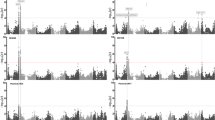Summary
Theory and methods for identifying inbred lines (I w) with favorable dominant alleles not present in an elite single cross (I 1×I 2) have been developed recently. Selected I w lines can be crossed to I 1 or to I 2 to transfer new favorable alleles to the single cross. However, favorable alleles already present in the single cross may be lost during selection. It is important to consider both potential gain of favorable alleles from I w and loss of favorable alleles already present in I 1×I 2. The “net improvement” statistic (NI)=maximum [(I 1×I w-I 1xI 2)/2, (I 2×I w-I 1×I 2)/2] estimates the number of loci where favorable alleles can be gained minus the number of loci where favorable alleles can be lost in the single cross. Because I 1×I 2 is constant in an experiment, the method reduces to choosing I w lines with the best mean performance in combination with either I 1 or I 1. NI was compared to estimators previously proposed for identifying lines, namely: (1) minimally biased estimates (μG′) of favorable dominant alleles present in I w but not in I 1 and I 2; (2) minimum estimate of an upper bound (UBND) on μG; and (3) predicted three-way cross (PTC) performance. Based on a set of maize (Zea mays L.) grain yield data, correlations among the four estimators were relatively high, but indicated that rankings of I w lines vary with the particular estimator used. Rankings of three I w lines based on the frequency of F2 test crosses superior to B73×Mo17 were identical to rankings based on NI, but differed from rankings based on μG′, PTC, and UBND. NI also was the best predictor of the mean of the upper 10% ({ovx}0.1) of (I 2×I w) F2×I 1 or (I 1×I w) F2×I 2 test crosses based on simulated data. Being a simple statistic highly correlated to {ovx}0.1, NI may be useful in applied breeding programs.
Similar content being viewed by others
References
Comstock RE (1974) Consequences of genetic linkage. In: Proc 1st World Congr Genet Appl Anim Prod, Madrid, pp 353–364
Dudley JW (1982) Theory for transfer of alleles. Crop Sci 22:631–637
Dudley JW (1984) A method of identifying lines for use in improving parents of a single cross. Crop Sci 24:355–357
Dudley JW (1987) Modification of methods for identifying inbred lines useful for improving parents of elite single crosses. Crop Sci 27:944–947
Falconer DS (1982) Introduction to quantitative genetics. Longman, New York
Gerloff JE, Smith OS (1988) Choice of method for identifying germ plasm with superior alleles. 1. Theoretical results. Theor Appl Genet 76:209–216
Johnson GR (1980) Simple quantitative theory for selection during inbred line development. Ill. Corn Breeders' School 16:1–18
Mišević D (1989a) Identification of inbred lines as a source of new alleles for improvement of elite maize single crosses. Crop Sci 29:1120–1125
Mišević D (1989b) Evaluation of three test statistics used to identify maize inbred lines with new favorable alleles not present in elite single cross. Theor Appl Genet 77:402–408
Sprague GF, Eberhart SA (1977) Corn breeding. In: GF Sprague (ed) Corn and corn improvement, 2nd edn. Academic Press, New York, pp 221–292
Zanoni U, Dudley JW (1989a) Comparison of different methods of identifying inbreds useful for improving elite maize hybrids. Crop Sci 29:577–582
Zanoni U, Dudley JW (1989b) Test cross evaluation of F2 populations from maize inbreds selected for unique favorable alleles. Crop Sci 29:589–595
Author information
Authors and Affiliations
Additional information
Communicated by A. R. Hallauer
A contribution from Lifaco Genetics, a Groupe Limagrain company
Rights and permissions
About this article
Cite this article
Bernardo, R. An alternative statistic for identifying lines useful for improving parents of an elite single cross. Theoret. Appl. Genetics 80, 105–109 (1990). https://doi.org/10.1007/BF00224022
Received:
Accepted:
Issue Date:
DOI: https://doi.org/10.1007/BF00224022




